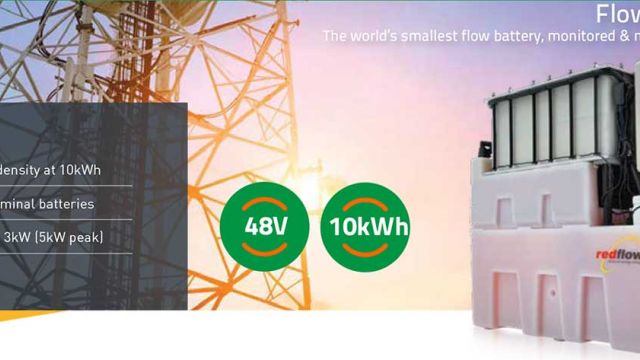Understanding the Redflow battery

Flow
Battery Characteristics
In its general definition, a flow battery features an electrolyte flowing continuously between a storage compartment (i.e. one or more tanks) and a reaction chamber where the electrodes are placed. Compared to a lead-acid battery, a flow battery contains more components and greater design complexity, with moving parts and sophisticated chemical containment. These batteries are typically deployed in stationary energy storage applications as changes to the system vertical alignment or changes in momentum or inertia Redflow delivers a new type of battery Redflow is a publicly-listed Australian company that has developed the world’s smallest zinc-bromine flow battery, that can be used anywhere from individual homes right up to grid-scale deployment can negatively affect the electrolyte flow, and thus the battery’s electrical performance.
The ZBM2 onboard Module Management System (MMS), which controls and safeguards the battery, adds an active element to each battery that is not present in standard batteries. While it increases the battery’s complexity, the MMS provides advantageous functions that enable the ZBM2 to be self-managing and to protect itself against potential environmental or operational damage risks. Where a ZBM2 replaces a conventional battery in
ZBM2 Battery Advantages
The various flow battery characteristics discussed in this section can be leveraged to deliver unique advantages in an energy storage system using the ZBM2 zinc-bromine flow battery. Stack and tank separation.
As with most flow
batteries, the Redflow ZBM2 features a separation of the energy section – the
tanks filled
with the electrolyte – and the
power section – the stack composed by electrodes. This separation enables
unique advantages for flow
batteries, such as flexibility in design and recycling of the battery parts at
the end of life. Thus, the
Redflow ZBM2 is one of the most sustainable and cost-effective batteries
available today.
Decreased
likelihood of theft
Another advantage of the ZBM2 battery over legacy technologies such as lead-acid batteries is the reduced risk of theft in the field. Conventional battery banks, which contain several 2V, 6V or 12V batteries, are attractive targets for theft as these single elements can be sold or reused. The uniqueness of the ZBM2 design and components mean that the battery is of little value to a potential thief outside of the application for which it has been designed. Also, with a total weight of about 240kg, the ZBM2 is too heavy for routine incidents of opportunistic theft to which conventional batteries are prone in remote field applications.
Control of immediate shut down
The separation of power and energy components in the ZBM2 battery also permits a shutdown within seconds by interrupting power supply to the flow pumps. Since no reactants are supplied to the electrodes after the pumps stop running, no electrical energy is transferred, so the system becomes still and safe. This enables the safe transport of ZBM2 batteries in this shutdown state. Also, a ZBM2 suffering mechanical damage does not risk explosion, dangerous high current output from short-circuit, or “thermal runaway”.


